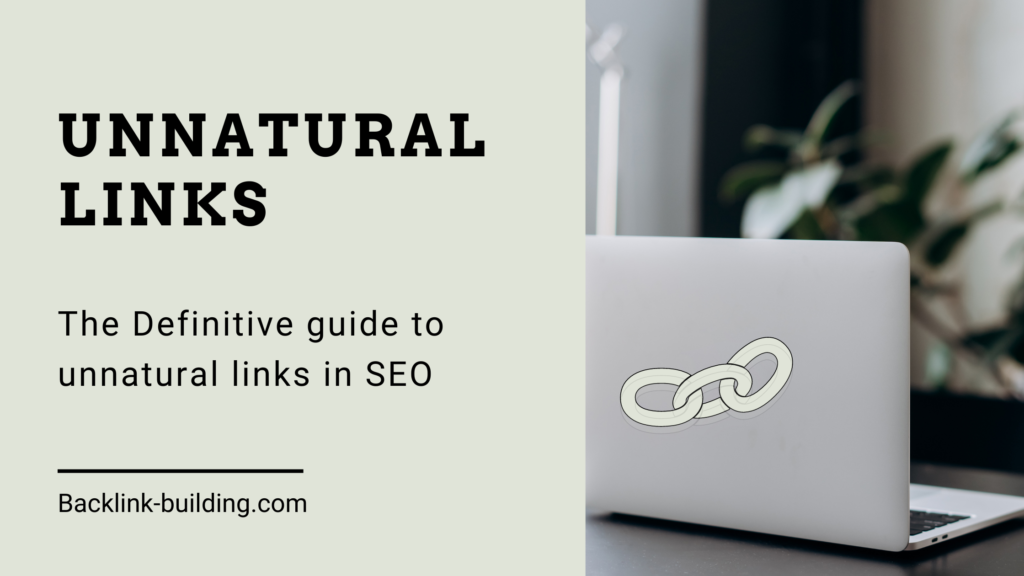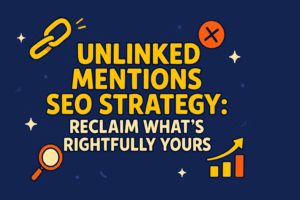
In the dynamic world of Search Engine Optimization (SEO), links are crucial in determining a website’s visibility and authority on the internet.
Links are often viewed as votes of confidence from one site to another, indicating relevance, credibility, and trustworthiness. However, not all links are created equal.
A category known as “unnatural links” can significantly affect a website’s SEO performance and even its existence in search engine results pages (SERPs).
This article delves deep into unnatural links: what they are, how to identify them, their impact on SEO efforts, and, most importantly, strategies to effectively address and mitigate their risks.
What Are Unnatural Links?

Unnatural links manipulate a site’s ranking in search engine results. These links are typically created solely for SEO rather than genuine user interest or relevance.
Common examples include paid links, link exchanges, or links embedded in spammy comments. Search engines like Google view unnatural links as violating their guidelines because they distort the natural link ecosystem.
In this ecosystem, links are earned organically based on the merit and quality of content. When a site accumulates many unnatural links, it can face penalties from search engines, such as reduced ranking or deindexing.
Identifying unnatural links involves looking for patterns of links that appear forced or irrelevant. For instance, a site with numerous inbound links from unrelated or low-quality websites could be a red flag.
Web admins should focus on building a diverse and authentic backlink profile through high-quality content and legitimate marketing efforts.
Addressing and removing unnatural links is crucial for maintaining a site’s SEO health and ensuring compliance with search engine guidelines.
Types Of Unnatural Link Building:
Here are some common types:
- Paid Links: Paid links involve purchasing links from other websites to pass PageRank, which violates search engine guidelines.
- Link Exchanges: Reciprocal linking where sites agree to link to each other to manipulate rankings.
- Private Blog Networks (PBNs): Networks of websites created solely for linking purposes, often with low-quality content.
- Link Farms: Websites or pages with hundreds or thousands of outbound links designed solely to manipulate search rankings.
- Irrelevant or Low-Quality Directories: Listing a website in directories that are irrelevant to its niche or are of low quality.
- Forum and Blog Spam: Forum and Blog Spam involves posting links in comments or forums solely for link-building, typically without contributing meaningful value to the discussion.
- Widget Links: Embedding widgets or infographics with embedded links irrelevant to the content they appear in.
- Footer and Sidebar Links: Placing links in the footer or sidebar of websites, especially when they are sitewide and not contextually relevant.
- Article Spinning and Link Insertion: Creating low-quality articles spun or duplicated across multiple sites with inserted links.
- Anchor Text Over-Optimization: Using exact-match anchor text excessively to manipulate search rankings.
These practices can lead to penalties from search engines like Google, resulting in lower rankings or even removal from search results altogether.
Websites must focus on natural, organic link-building strategies prioritizing relevance, quality, and user value.
Why Are Unnatural Links A Concern?
Unnatural links are a significant concern in search engine optimization (SEO) due to their potential to manipulate rankings.
Search engines like Google prioritize natural, organic links as indicators of a website’s credibility and relevance.
In contrast, unnatural links, often acquired through artificial means such as link farms, reciprocal link schemes, or paid placements, can deceive search algorithms into ranking a website higher than it deserves.
This practice undermines the principle of fair competition and diminishes the quality of search results for users.
From an SEO perspective, unnatural links can lead to penalties or deindexing by search engines if detected, harming a website’s visibility and traffic.
They can damage a website’s reputation among users and other web admins, affecting trust and credibility.
Web admins and SEO professionals are thus advised to build high-quality, relevant links through legitimate methods, such as producing valuable content, fostering genuine relationships with other sites, and earning links naturally.
This approach improves SEO and positively affects a website’s long-term sustainability and online reputation.
Potential Consequences Of Unnatural Links:
Unnatural links are acquired through manipulative or deceptive practices rather than naturally earned through quality content and genuine relationships.
Here are some potential consequences of using unnatural links:
- Penalties from Search Engines: Search engines like Google penalize websites with unnatural linking practices. This can result in a significant drop in search engine rankings or even removal from search results altogether.
- Loss of Trust and Reputation: Using unnatural links can damage a website’s trustworthiness and reputation. Visitors who suspect manipulative tactics may view the site as untrustworthy or spammy.
- Decreased Organic Traffic: With search engine penalties, organic traffic to the website can plummet, leading to fewer visitors and potential customers finding the site through search engines.
- Manual Actions: Search engines may issue manual actions against the site, requiring web admins to take specific corrective actions before their site can be reconsidered for ranking.
- Negative SEO: Competitors or malicious entities might intentionally build unnatural links to a website to harm its search engine rankings and reputation.
- Difficulty in Recovery: Recovering from penalties due to unnatural links can be time-consuming and challenging. It often requires a thorough audit, removal of unnatural links, and submitting a reconsideration request to search engines.
- Financial Loss: Businesses relying on organic search traffic for sales or leads can suffer financially due to decreased visibility and traffic resulting from search engine penalties.
Identifying Unnatural Links
Manual Review vs. Algorithmic Detection
Identifying unnatural links can be done through both manual review and algorithmic detection methods. Search engines like Google employ sophisticated algorithms that continually evolve to detect patterns indicative of unnatural linking practices.
These algorithms analyze factors such as link quality, relevance, and the context in which links are placed.
Manual Review:
- Link Audit: Conducting a comprehensive website backlink profile audit to identify suspicious or unnatural links.
- Review of Link Sources: Evaluating the credibility and relevance of websites linking to the site.
- Anchor Text Analysis: Assessing the distribution and nature of anchor text used in inbound links to ensure it appears natural and diverse.
Algorithmic Detection:
- Google Penguin Algorithm: Specifically designed to identify and penalize websites engaged in manipulative linking practices.
- Quality Guidelines: Search engines publish guidelines that outline acceptable linking practices, which serve as a benchmark for assessing the legitimacy of links.
Tools For Identifying Unnatural Links
Identifying unnatural links involves a mix of manual and automated tools. Here are some commonly used tools and methods:
- Google Search Console (GSC):
- Check for manual actions or messages related to unnatural links.
- Use the “Links” report to identify potentially spammy or unnatural links pointing to your site.
2. Backlink Analysis Tools:
- Ahrefs: Provides insights into backlink profiles, including domain rating (DR), and flags potentially toxic or unnatural links.
- Majestic: Offers Trust Flow and Citation Flow metrics, helping to assess link quality.
- SEMrush: Analyzes backlinks and can identify toxic links that may harm your site’s SEO.
3. Link Detox Tools:
- LinkResearchTools: Offers a comprehensive link audit, detects toxic links, and provides a disavow file for Google.
- Monitor Backlinks: Monitor backlinks and alert you to suspicious or unnatural patterns.
4. Manual Review:
- Review each link manually to assess relevance, context, and quality. Look for signs like irrelevant anchor text, low-quality domains, or sudden link spikes.
5. Google’s Disavow Tool:
- Use this tool to request Google to ignore specific links when assessing your site’s backlink profile.
6. SEO Auditing Tools:
- Tools like Screaming Frog SEO Spider can help identify potential issues with your site, including links to and from it.
7. Webmaster Guidelines:
- Follow Google’s link schemes and quality guidelines, ensuring your site complies with best practices.
By combining these tools and methods, you can effectively identify and manage unnatural links that may negatively impact your site’s SEO performance.
Addressing Unnatural Links
If you discover unnatural links pointing to your website, taking action promptly to avoid penalties and restore your SEO health is essential. Here are steps to address unnatural links:
Audit Your Backlink Profile:
Use tools like Google Search Console, Ahrefs, or Moz to audit your backlinks thoroughly. Based on the criteria mentioned earlier, identify links that appear unnatural.
Contact Webmasters:
For links you can identify as paid or otherwise unnatural, contact the site admins and request their removal. Be polite and provide specific details about the links you want removed.
Disavow Tool:
Google provides a Disavow Tool through Google Search Console for links that cannot be removed manually. This tool allows you to ask Google not to consider certain links when assessing your site.
Improve Link-Building Strategies:
Focus on building high-quality, natural backlinks through content marketing, guest blogging on reputable sites, and fostering relationships with influencers and industry peers.
Monitor Regularly:
Monitor your backlink profile regularly to ensure new links are acquired naturally and any new unnatural links are promptly addressed.
Best Practices For Sustainable Link Building
To avoid the pitfalls associated with unnatural links, adopt a proactive approach to link-building that emphasizes quality, relevance, and organic growth:
1. Content Quality:
- Create Compelling Content: Develop valuable, informative, and shareable content that naturally attracts links from reputable sources.
- Promote Engagement: Encourage social sharing and engagement to increase the visibility and reach of content organically.
2. Natural Link Acquisition:
- Earn Editorial Links: Focus on earning links from authoritative websites through high-quality content and thought leadership.
- Build Relationships: Cultivate relationships with influencers and industry peers who may naturally link to your website.
3. Diversified Anchor Text:
- Use Varied Anchor Text: To avoid over-optimization, employ a diverse range of anchor text, including branded terms, partial matches, and generic phrases.
4. Monitoring and Maintenance:
- Regular Audits: Conduct periodic audits of your backlink profile to identify emerging issues or potential risks.
- Stay Informed: Keep abreast of changes to search engine algorithms and guidelines to adapt your SEO strategies accordingly.
FAQ’S
What Is An Example Of A Natural Link?
Ans: A natural link is a hyperlink added to a webpage organically, without any direct influence from the link’s target website.
For instance, if a food blogger writes a review about a new restaurant and includes a link to the restaurant’s website, that link is considered natural.
Such links occur because the content creator finds the target site relevant and valuable to their audience. Natural links are not paid for or exchanged through any formal arrangement, and they typically arise from genuine interest or usefulness. Search engines highly value these links for SEO purposes.
Conclusion
While backlinks remain a critical factor in SEO, it is essential to distinguish between natural and unnatural links.
Unnatural link-building practices can lead to severe search engine penalties and damage your website’s reputation and visibility.
By understanding the types of unnatural links, identifying them proactively, and implementing appropriate remedial actions, website owners and SEO professionals can safeguard their sites against potential penalties and maintain a healthy SEO strategy focused on genuine value and authority.
Adopting ethical SEO practices, such as creating high-quality content, building genuine relationships, and earning natural backlinks, improves search engine rankings and contributes to a sustainable online presence that resonates with users and search engines alike.
By adhering to these principles, web admins can navigate the complexities of link-building in the modern SEO landscape.
Do you have any questions about unnatural links or Google penalties? Let us know in the comments below. We would be happy to answer you.
Thanks for Reading:)


